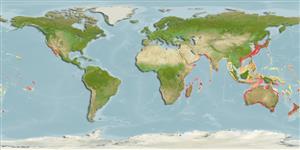Preferred temperature (ເອກະສານອ້າງອີງ
123201): 10.8 - 24.3, mean 18.7 °C (based on 185 cells).
Phylogenetic diversity index (ເອກະສານອ້າງອີງ
82804): PD
50 = 0.5625 [Uniqueness, from 0.5 = low to 2.0 = high].
Bayesian length-weight: a=0.00912 (0.00801 - 0.01039), b=3.05 (3.02 - 3.08), in cm total length, based on LWR estimates for this species (Ref.
93245).
ຊັ້ນເຂດຮ້ອນ (ເອກະສານອ້າງອີງ
69278): 4.2 ±0.5 se; based on diet studies.
ຄວາມຢືດຢຸ່ນ (ເອກະສານອ້າງອີງ
120179): ຂະໜາດກາງ, ປະຊາກອນຕຳ່ສຸດທີ່ໃຊ້ເວລາສອງເທົ່າ 1.4 - 4.4 ປີ (K=0.28).
Prior r = 0.60, 95% CL = 0.39 - 0.90, Based on 1 full stock assessment.
Fishing Vulnerability (Ref.
59153): Moderate vulnerability (43 of 100).
🛈
Climate Vulnerability (Ref.
125649): Low to moderate vulnerability (30 of 100).
🛈
Nutrients (Ref.
124155): Calcium = 52.1 [17.4, 129.4] mg/100g; Iron = 2 [1, 5] mg/100g; Protein = 21 [20, 22] %; Omega3 = 0.392 [0.257, 0.600] g/100g; Selenium = 74.3 [27.5, 192.3] μg/100g; VitaminA = 24.7 [5.9, 109.4] μg/100g; Zinc = 0.822 [0.487, 1.377] mg/100g (wet weight);
